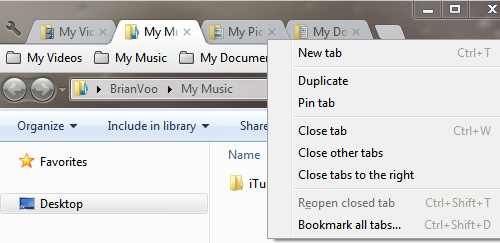Add Tab Browsing to Windows Explorer with Clover
Note: This post was first published on October 11, 2012.
Managing multiple folders can make your desktop cluttered. Navigating through a sea of open windows can be overwhelming, making it difficult to find what you need. It’s understandable that some prefer a tab setup like what we see on Chrome. This makes navigating, opening, and closing tabs more manageable.
Luckily, you can achieve this functionality with a little help from Clover. Clover integrates tab browsing into Windows Explorer, allowing you to manage your folders as you would browser tabs, helping you work more efficiently.
Using Clover
First, download and install Clover. You’ll notice the clover leaf icon on the taskbar, indicating its integration.

From now on, Clover will handle all your folders. Every new folder you open will appear in a new tab, similar to browser tabs on Google Chrome. Opening a new tab will take you to My Computer by default.

Bookmark Bar
Clover also provides a bookmark bar, allowing you to organize and run .exe files directly from it. You can also group programs into folders, making program navigation easier.
For example, we’ve created this ‘Favorites’ folder below. You can store the locations of folders such as ‘My Documents’ and ‘My Pictures’ and even launch programs from it – launch the last link in the shot below to run iTunes.

Clover Keyboard Shortcuts
Similar to Google Chrome, Clover supports various basic keyboard shortcuts, making it easier and faster to navigate through your tabbed folders.
| Shortcuts | Description |
| Ctrl + N | Open a new Clover window. |
| Ctrl + T | Open a new tab. |
| Ctrl + W | Close current tab. |
| Ctrl + Shift + T | Re-open last closed tab. |
| Ctrl + D | Bookmark current folder. |
| Ctrl + Shift + D | Place all opened tabs into a bookmarked folder. |
| Ctrl + Tab | Switch to next tab. |
| Ctrl + Shift + Tab | Switch to previous tab. |
| Ctrl + Shift + B | Enable or disable bookmark bar. |
These are shortcut keys that most users know intuitively.
More Tips
Here are a few more tips to help you become a Clover power user.
Clicking
-
Double-clicking a tab closes it.
-
Middle-clicking (mouse wheel click) on a tab closes it.
-
Holding Ctrl while double-clicking a folder opens that folder in a new tab.
-
Right-clicking a folder and pressing E opens it in a new tab.
- Middle-clicking a bookmark opens the location in a new tab.
Dragging
-
Dragging folders to the bookmark bar bookmarks them.
-
Dragging folders to the tab bar opens them in new tabs.
-
Dragging folders onto an existing tab replaces that tab with the dragged folder.
- Dragging a tab outside of the current window opens it in a new window.
Conclusion
Clover is a powerful and simple add-on to improve your Windows navigation and organization. It’s lightweight and doesn’t consume much RAM even when managing multiple tabs.
Future updates may include features like custom folder icons on the bookmark bar. You can follow their updates on this Google-translated website, but even with its current features, Clover is a valuable download.